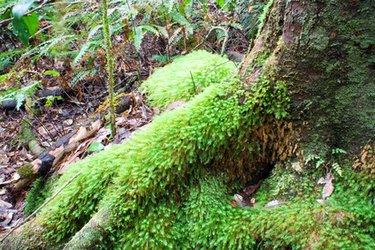
The growth of moss on the surface of flower beds and other cultivated areas is less a menace to other plants than it is an indicator of soil and moisture conditions that may or may not be favorable for the garden plants you have chosen. In some instances, moss is viewed as a positive addition, providing soil stabilization on erosion-prone slopes, soil cooling for shallow-rooted cultivars and companion planting for ferns and other shade garden plants.
What Causes Moss to Grow?
Video of the Day
Moss is a type of fungus. It does not have deep roots--so it does not compete with other plants for soil nutrients--and tends to thrive in moist, acidic (low pH) soils. Many shrubs and flowers prefer neutral and even alkaline (high pH) conditions. Unless you are growing acid-loving plants like rhododendrons, forest ferns or camellias, the presence of moss is a symptom of soil conditions that prevent some flowers and shrubs from thriving.
Video of the Day
Mechanical Removal
Since moss is so shallow rooted, you can scrape moss from the surface of your soil with a hoe or other light garden tool without disturbing the roots of your other garden plants. It will generally come back over time, but if the area is small, or if you want to keep the soil acidic for your other plants, this may be all you need to do.
Chemical Removal
There are moss-killing commercial products available at your local garden center. These are not generally considered appropriate for vegetable or herb gardens, but can be used in lawns and flower beds. Application forms include liquid spray or granules that you sprinkle over the surface of the soil and moss. Pay close attention to application instructions on the containers, to avoid accidental damage to other plants.
Amending Garden Soil
If your preferred flowers and shrubs need non-acidic soil that drains better, the moss is your red flag that the soil should be amended. This approach will both improve the health of the other plants and create inhospitable conditions for the moss.
Soil amendments that raise pH include limestone, wood ash, bone meal and oyster shell. Consult your local garden center for a kit to test your pH. Some stores will test it for you if you bring in a sample. The amendment packaging or a knowledgeable salesperson will give the application rate--the amount of amendment to use for your square feet of space.
If you have not already planted your garden, you can till in enough of your chosen amendment all at once to bring soil pH into line with your needs. If the garden is already planted, be more cautious and add the amendment over time because a sudden change in pH is as shocking to a plant as a sudden frost would be.
In the latter instance, scrape the moss aside, rough up the soil surface to a depth that won't disturb the other plant roots, and sprinkle on some of your amendment. You can then let water and time take the amendment into the soil gradually. Let the general health of the plants be your guide to further applications. If they look good and the moss doesn't come back, then you're done.
Tips
Don't overdo alkaline amendments. If you take pH too high, it will cause some soil nutrients to become unavailable to your plants.
Sunlight and dryness are the enemies of moss. A sunny, well-drained area shouldn't grow much moss.